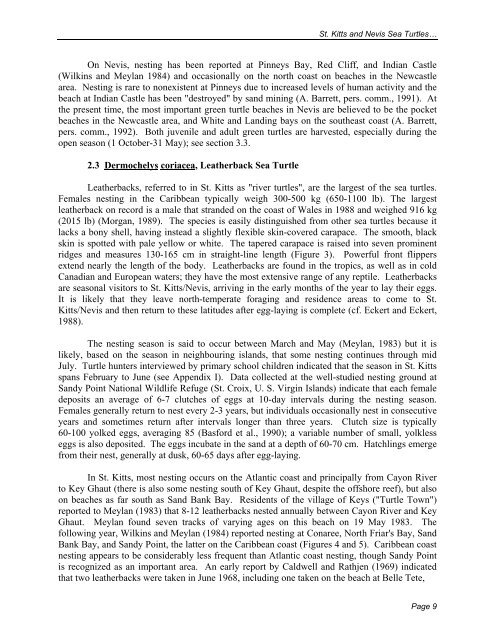Sea Turtle Recovery Action Plan for St. Kitts and Nevis - WIDECAST
Sea Turtle Recovery Action Plan for St. Kitts and Nevis - WIDECAST
Sea Turtle Recovery Action Plan for St. Kitts and Nevis - WIDECAST
You also want an ePaper? Increase the reach of your titles
YUMPU automatically turns print PDFs into web optimized ePapers that Google loves.
<strong>St</strong>. <strong>Kitts</strong> <strong>and</strong> <strong>Nevis</strong> <strong>Sea</strong> <strong>Turtle</strong>s…<br />
On <strong>Nevis</strong>, nesting has been reported at Pinneys Bay, Red Cliff, <strong>and</strong> Indian Castle<br />
(Wilkins <strong>and</strong> Meylan 1984) <strong>and</strong> occasionally on the north coast on beaches in the Newcastle<br />
area. Nesting is rare to nonexistent at Pinneys due to increased levels of human activity <strong>and</strong> the<br />
beach at Indian Castle has been "destroyed" by s<strong>and</strong> mining (A. Barrett, pers. comm., 1991). At<br />
the present time, the most important green turtle beaches in <strong>Nevis</strong> are believed to be the pocket<br />
beaches in the Newcastle area, <strong>and</strong> White <strong>and</strong> L<strong>and</strong>ing bays on the southeast coast (A. Barrett,<br />
pers. comm., 1992). Both juvenile <strong>and</strong> adult green turtles are harvested, especially during the<br />
open season (1 October-31 May); see section 3.3.<br />
2.3 Dermochelys coriacea, Leatherback <strong>Sea</strong> <strong>Turtle</strong><br />
Leatherbacks, referred to in <strong>St</strong>. <strong>Kitts</strong> as "river turtles", are the largest of the sea turtles.<br />
Females nesting in the Caribbean typically weigh 300-500 kg (650-1100 lb). The largest<br />
leatherback on record is a male that str<strong>and</strong>ed on the coast of Wales in 1988 <strong>and</strong> weighed 916 kg<br />
(2015 lb) (Morgan, 1989). The species is easily distinguished from other sea turtles because it<br />
lacks a bony shell, having instead a slightly flexible skin-covered carapace. The smooth, black<br />
skin is spotted with pale yellow or white. The tapered carapace is raised into seven prominent<br />
ridges <strong>and</strong> measures 130-165 cm in straight-line length (Figure 3). Powerful front flippers<br />
extend nearly the length of the body. Leatherbacks are found in the tropics, as well as in cold<br />
Canadian <strong>and</strong> European waters; they have the most extensive range of any reptile. Leatherbacks<br />
are seasonal visitors to <strong>St</strong>. <strong>Kitts</strong>/<strong>Nevis</strong>, arriving in the early months of the year to lay their eggs.<br />
It is likely that they leave north-temperate <strong>for</strong>aging <strong>and</strong> residence areas to come to <strong>St</strong>.<br />
<strong>Kitts</strong>/<strong>Nevis</strong> <strong>and</strong> then return to these latitudes after egg-laying is complete (cf. Eckert <strong>and</strong> Eckert,<br />
1988).<br />
The nesting season is said to occur between March <strong>and</strong> May (Meylan, 1983) but it is<br />
likely, based on the season in neighbouring isl<strong>and</strong>s, that some nesting continues through mid<br />
July. <strong>Turtle</strong> hunters interviewed by primary school children indicated that the season in <strong>St</strong>. <strong>Kitts</strong><br />
spans February to June (see Appendix I). Data collected at the well-studied nesting ground at<br />
S<strong>and</strong>y Point National Wildlife Refuge (<strong>St</strong>. Croix, U. S. Virgin Isl<strong>and</strong>s) indicate that each female<br />
deposits an average of 6-7 clutches of eggs at 10-day intervals during the nesting season.<br />
Females generally return to nest every 2-3 years, but individuals occasionally nest in consecutive<br />
years <strong>and</strong> sometimes return after intervals longer than three years. Clutch size is typically<br />
60-100 yolked eggs, averaging 85 (Bas<strong>for</strong>d et al., 1990); a variable number of small, yolkless<br />
eggs is also deposited. The eggs incubate in the s<strong>and</strong> at a depth of 60-70 cm. Hatchlings emerge<br />
from their nest, generally at dusk, 60-65 days after egg-laying.<br />
In <strong>St</strong>. <strong>Kitts</strong>, most nesting occurs on the Atlantic coast <strong>and</strong> principally from Cayon River<br />
to Key Ghaut (there is also some nesting south of Key Ghaut, despite the offshore reef), but also<br />
on beaches as far south as S<strong>and</strong> Bank Bay. Residents of the village of Keys ("<strong>Turtle</strong> Town")<br />
reported to Meylan (1983) that 8-12 leatherbacks nested annually between Cayon River <strong>and</strong> Key<br />
Ghaut. Meylan found seven tracks of varying ages on this beach on 19 May 1983. The<br />
following year, Wilkins <strong>and</strong> Meylan (1984) reported nesting at Conaree, North Friar's Bay, S<strong>and</strong><br />
Bank Bay, <strong>and</strong> S<strong>and</strong>y Point, the latter on the Caribbean coast (Figures 4 <strong>and</strong> 5). Caribbean coast<br />
nesting appears to be considerably less frequent than Atlantic coast nesting, though S<strong>and</strong>y Point<br />
is recognized as an important area. An early report by Caldwell <strong>and</strong> Rathjen (1969) indicated<br />
that two leatherbacks were taken in June 1968, including one taken on the beach at Belle Tete,<br />
Page 9
















